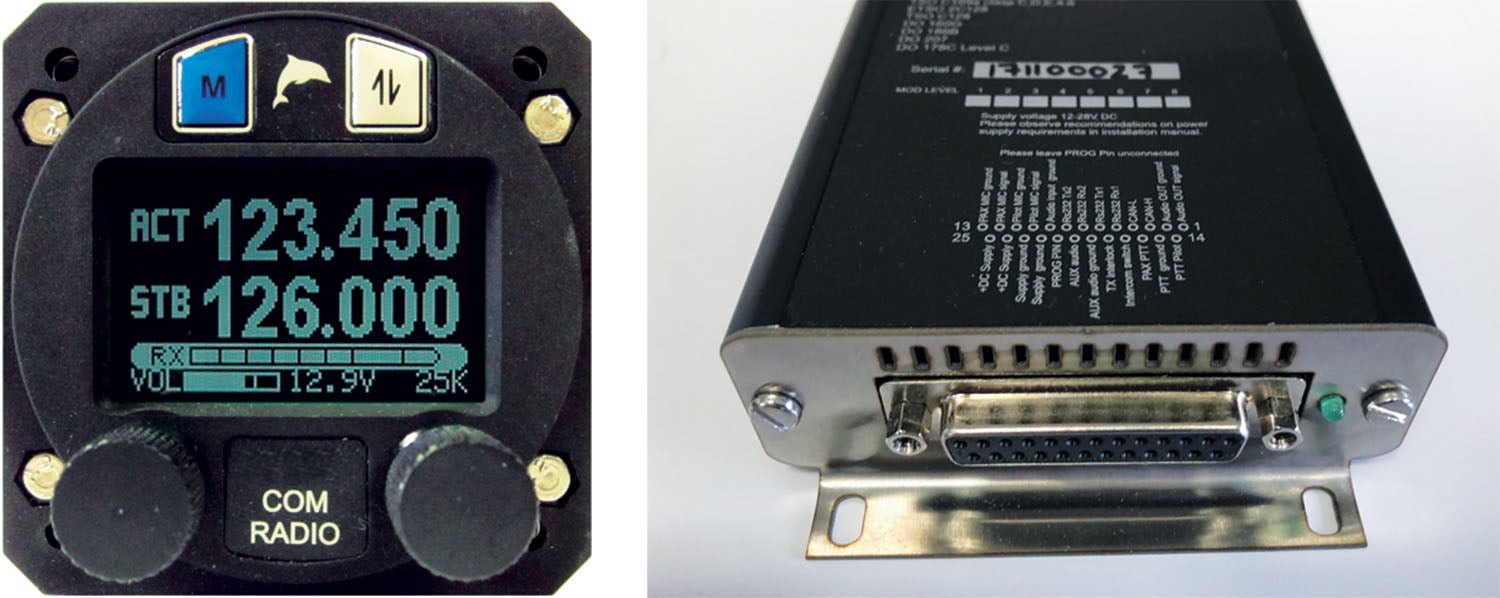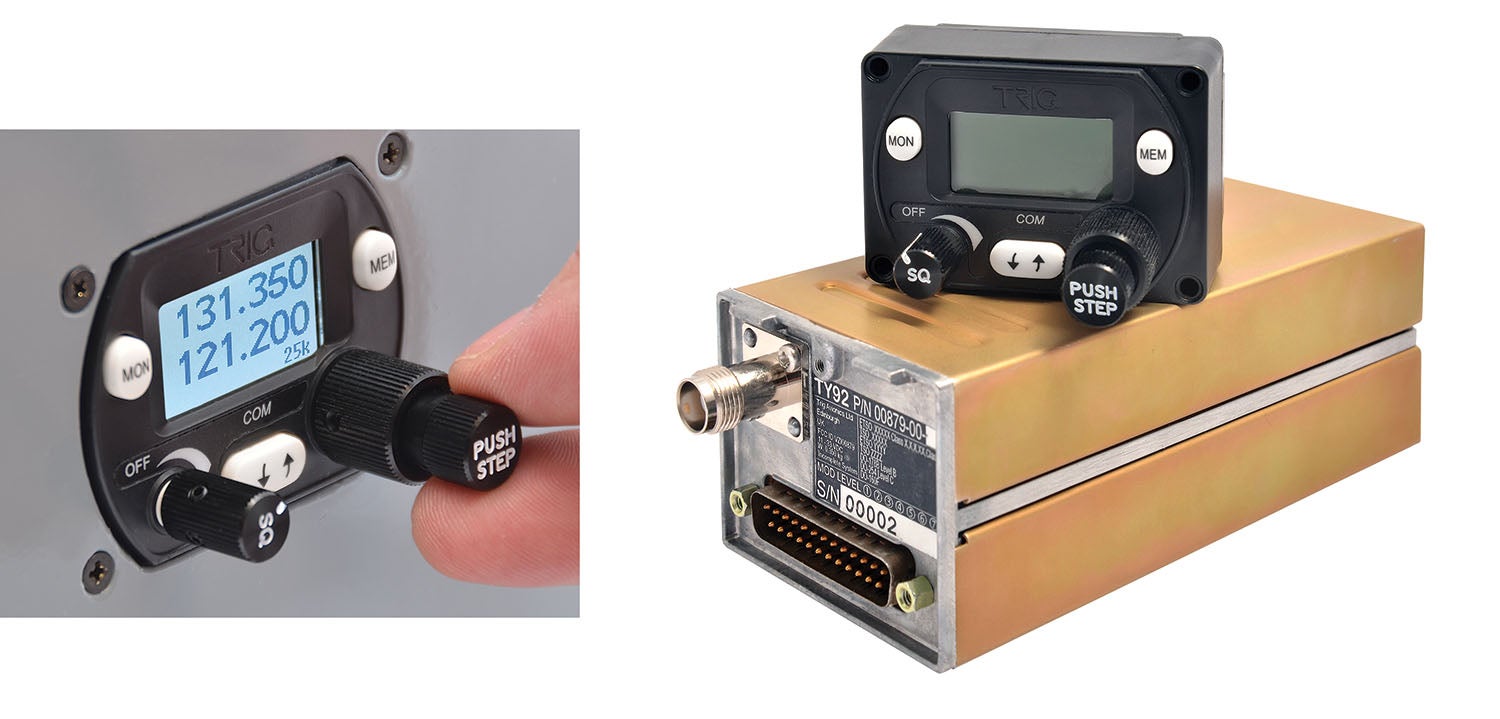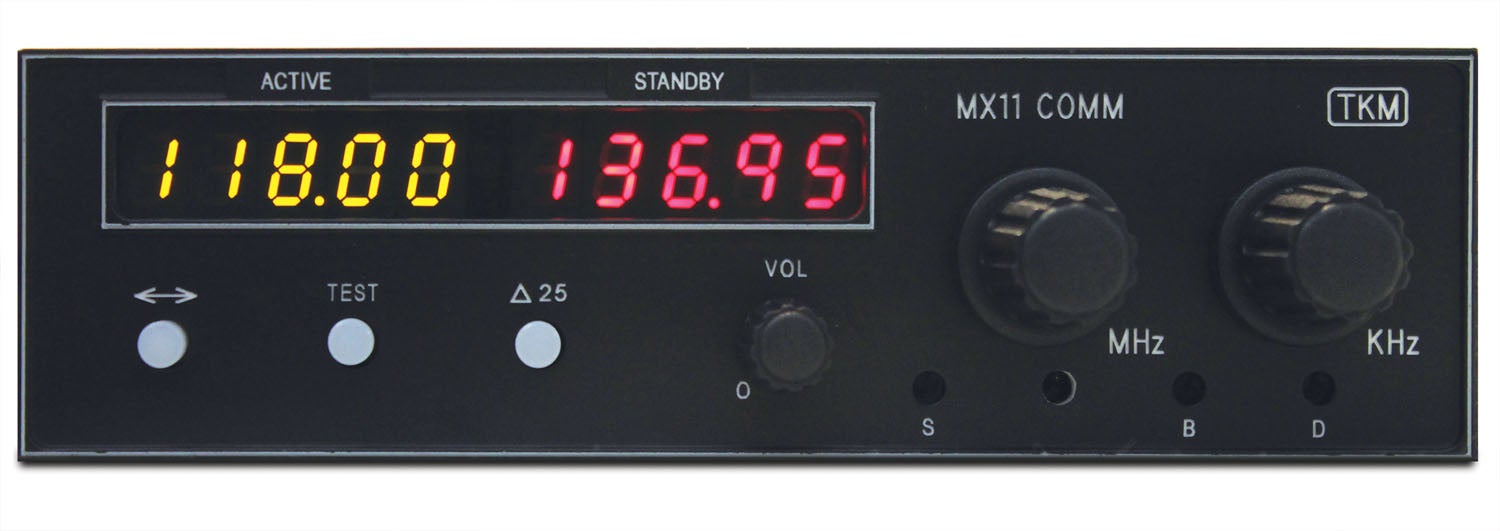 Unless you fly around the most unpopulated pastures, the VHF com radio remains the most important unit in the radio stack. If you haven’t shopped the standalone transceiver market in awhile, you’ll be surprised to see advanced feature sets, space-saving designs and smart data-bus compatibility with EFIS and GPS navigators. That’s all good, whether you’re equipping with a full-up EFIS suite or taking a building-block approach with a low-cost utilitarian radio package that will stand on its own for now.
Unless you fly around the most unpopulated pastures, the VHF com radio remains the most important unit in the radio stack. If you haven’t shopped the standalone transceiver market in awhile, you’ll be surprised to see advanced feature sets, space-saving designs and smart data-bus compatibility with EFIS and GPS navigators. That’s all good, whether you’re equipping with a full-up EFIS suite or taking a building-block approach with a low-cost utilitarian radio package that will stand on its own for now.
And even if you’re just replacing an aging radio in an existing aircraft, the good news is there are plenty of choices for stack- and instrument-hole-mounted transceivers that are reasonably priced and packed with modern features. We went looking for the latest ones and prepared this market scan. Incidentally, we have not included Microair here—despite multiple attempts, we never heard back from the company regarding current offerings, prices and specifications.
Becker
The company is long known for building gear with space-saving and rugged hardware, good performance and low current draw. The latest transceiver line is the 620-series, with several models separated by their mounting design—remote, rack and instrument-hole mount.
For self-contained stack mounting, the 6.3-inch (which is the industry-standard rack width) radio is the $1300 AR-6203. It uses 2.4 inches of vertical space and 8.8 inches of depth behind the panel. It weighs just shy of 2 pounds and has a 6-watt transmitter in 14-volt installations and 10 watts in 28-volt installations.

The rack-mounted 6203 has reasonable amounts of modern features, including a four-place VOX-controlled intercom with dual-stick (or yoke) push-to-talk capability, auxiliary audio input and the ability to interface with a second control head, which is the $778 RCU6201. This is useful in tandem cockpits, with the main unit and remote head connecting via serial data. There’s also a 99-channel memory bank with user-defined text labels assignable for each frequency and the unit automatically stores the nine most recently selected frequencies. A Scan mode monitors the audio of the standby frequency.
The radio has a backlit LCD, and it can be configured for internal key dimming or controlled with an external dimmer circuit. In addition to low current draw, we like the unit’s efficient power supply. If the input voltage drops below 10.25 volts, the transceiver will still operate but with degraded transmitter performance. If it drops below 9 volts, you’re out of usable power—and luck—as the unit powers off.
The version for mounting in a 2¼-inch instrument cutout is the $1300 (6-watt version) AR6201. It weighs 1.5 pounds and has a mounting depth of 9 inches. Like the rack-mounted 6203, the 6201 can also drive the RCU control head for tandem-cockpit installs. And if you don’t have the 9 inches of panel depth to work with, Becker sells the $1408 RT6201. It measures 2.4×2.4×7.4 inches and weighs 1.3 pounds. Mate it with an RCU6201 control head, which mounts in a 2¼-inch instrument cutout and requires a shallow 1.6 inches of depth.
While the Becker coms have a serial data interface for connecting to the RCU control head, the company couldn’t confirm compatibility with third-party EFISes for remote frequency control. Becker USA’s Ralph Schneider told us German-based Becker Avionics is starting to assemble select radios in its Miramar, Florida, facility, which has resulted in price reductions across the product line.
Garmin
Garmin’s standalone com transceiver for the Experimental market is the $1199 GTR 200, which replaced the Garmin/Apollo SL 40 several years ago. There’s also the $1395 GTR 200B Bluetooth-equipped version. More on that in a minute.
The GTR 200, which trickles down from the TSO-certified GTR 225 transceiver, transmits 10 watts of power and measures 1.4×6.25 inches. The radio makes use of a simple 37-pin connector, which stretches the chassis 9.3 inches deep. The entire system weighs just shy of 2 pounds, including mounting rack and connector hardware.

The radio’s display has a versatile 45° lateral viewing angle and measures 3.0×0.48 inches, with a 200×33-pixel resolution—a decent read in sunlight and in the dark. The radio has a 10-watt transmitter, plus an integral two-place stereo intercom with pilot isolation function.
The GTR 200 has some modern tricks, including a bezel key dedicated to monitoring the standby frequency. Garmin took the interface one step further and built in its 3D audio function, which trickles down from its flagship audio panels. This provides special separation of the standby and active frequency in each ear when wearing a stereo headset. The 3D function spills over to the intercom function, too, separating the passenger chatter from one ear to the other. You can also send in an auxiliary input (maybe music input or a landing gear or low-fuel warning) and that audio is controlled with a dedicated bezel key. If you want to pipe the entertainment audio in via Bluetooth, spend the extra $196 for the Bluetooth model—a no-brainer, in our estimation.
The GTR has smart automatic squelch circuitry that senses the noise level in the cockpit and adjusts the mic squelch appropriately. Pilot-configurable soft keys can provide single-button access to emergency frequency tuning, pilot audio isolation, saved frequencies list, music mute or push-to-talk. And kicking the interface up a notch is a smart feature that displays the facility name and type when you are tuning from one of the 20 user defined frequency preselects or selecting a frequency from one of the nearest or flight plan airports. These are transferred from later Garmin aviation portable navigators and the G3X Touch system.

Garmin says the GTR 200 was designed around the G3X Touch and connects with the suite over a CAN bus. That means the radio can be controlled completely from the G3X Touch screens (and from the radio itself, syncing the frequency readout on both displays). Needless to say, if you’re installing a Garmin G3X Touch, you’re more than likely also installing the GTR 200. There’s also the remote version—the GTR 20.
Icom
The current Icom transceiver for the Experimental market is the $1199 A220 (the pricier A220 TSO is for certified applications). It has an 8-watt transmitter, a bright OLED bezel display, two-place intercom and comes standard with both 8.33 and 25 kHz frequency channeling. There’s plenty of frequency storage capability, with 20 regular channels, 50 group channels, 10 GPS database-sourced frequencies (a healthy variety of RS-232-based navigators will work for sending in nearby facility frequencies automatically) and 10 NOAA Weather channels.

The A220 measures 1.3×6.25×10.7 inches and weighs a touch over 2 pounds. In addition to having a display with a wide viewing angle (it’s nearly 180°, offering more mounting flexibility), the A220 has smart features including Icom’s ANL (automatic noise limiter), which helps to reduce noise in the receiver. For the ham-fisted among us, there’s a dial and key lock to keep from inadvertently hitting the radio’s controls in turbulence. There’s a dedicated emergency key for 121.5 MHz and a Dualwatch mode (and dedicated bezel key) for monitoring the standby frequency.
Icom offers adapters for plug-and-play with some older radios, including King, and the unit is wired with a D-sub 25-pin connector. We’ve installed and used the A220 in a few applications and have been impressed with its performance and rugged control set.
MGL
At press time, Michigan Avionics has taken over all of the North American sales and support of the MGL Avionics line. We think that’s a good thing—the company was easy to get in touch with, had a good understanding of the MGL product line and was responsive and accommodating to our coverage. There are two com transceiver offerings in the MGL product line—the standalone V6 and the remote V16.
The $1195, LCD display-equipped V6 fits a 2-1/4-inch instrument cutout (it mounts from the rear of the panel for a flush fit) and has 6 watts of transmit power. It’s a featherweight at 8.8 ounces. The radio has some smart tech built in, including MGL’s proprietary VOGAD (voice-operated gain-adjusting device), which automatically adjusts the microphone gain as you speak, and the goal is to reduce background and engine noise in the carrier. There’s also a stuck microphone alerter and a computer interface for loading in frequencies for recall (the unit has a 100-channel frequency storage bank).

Operation is straightforward with two rotary knobs for volume and frequency tuning (which tunes in large steps when turned quickly, or in 25-kHz steps when tuned slowly). The V6 is compatible with MGL’s iEFIS system and also Dynon’s SkyView and Garmin’s G3X Touch for frequency transfer, it has audio outputs for interface with an external audio data recorder, a built-in two-place intercom with a dedicated stereo music input, plus two auxiliary channels for smartphone interface and EFIS annunciators. The radio emulates the discontinued Garmin SL 40 com radio’s popular data protocol for serial interfacing. The SL 40 (and the nav-equipped SL 30 and newer Garmin radios) can fetch frequencies across the serial lines from select navigator databases based on GPS position.
Interesting is that the V16 (when used with its Razor and Vega controllers) emulates Garmin’s GTR 200/225 radio data format, which ultimately means the G3X Touch can tune the V16 radio’s standby frequency plus command the flip-flop function without having to touch the Vega control head.
On a side note, Michigan Avionics (also an avionics installation center that builds custom harnesses and panels) told us users have been using the N16 VHF nav radio and Vega control head in Garmin G3X Touch suites as a way to equip for ground-based VHF nav. The idea is to remotely install the N16 nav behind the panel and control it through the Garmin G3X Touch display—skipping an integrated nav/com entirely, especially for builders with panel-mounted portable navigators. “This saves the cost of a GNC 255 (Garmin’s latest panel-mounted nav/com radio) at a nominal investment of around $5000,” Michigan Avionics’ Adam O’Connor said, noting the shop has seen impressive signal range from MGL radios that can better the ones inside some integrated navigators and standalone nav/coms.
Trig
Scotland-based Trig Avionics offers the Compact and Stack lines of VHF radios. The radio-stack-mounted models are the $1865 TY96A (10-watt transmitter) and $3048 TY97A (16-watt transmitter but only for 28-volt electrical systems). The radios stand 1.3 inches tall in a standard 6.2-inch-wide radio stack, require 10.6 inches of panel depth and weighs 2.1 pounds. No forced air cooling is required, says Trig.
The A-suffix Trig radios have basic 25 kHz channeling (the straight TY97 and 96 have both 25 kHz and 8.33 kHz channeling). All models come standard with a two-place stereo intercom and aux input for entertainment and warning systems.

The Trig radios can integrate with compatible GPS navigators using the Garmin SL 40 and GTR 225 data protocol to automatically display frequencies along a route, based on GPS position. As noted earlier, this is a serial data connection between the radio and the navigator.
The Trig radios also have a dedicated Mon bezel key for monitoring the audio of the standby frequency (something Trig calls Dual Watch), an Emer key for quick tuning the 121.5 MHz emergency frequency and a Play button for playing back 30 seconds of the previous receiver audio. The radio comes with a USB memory stick for building a customizable frequency database for loading (up to 200 channels and their associated facility names) into the radio as CSV files. The USB port is on the lower left front of the radio’s bezel and there’s a dedicated Mem key for accessing the frequencies.
The remote versions are the $1110 6-watt TY91 (for 14-volt electrical systems) and $2943 16-watt TY92 (for 28-volt systems). The remote transceiver has most of the features as the rack-mounted version including two-place stereo intercom, Dual Watch and a nine-frequency memory bank. You’ll have to find someplace to mount the transceiver, which shouldn’t be a big deal—it measures 1.9×2.6×6.3 inches. That’s reasonably compact. The control head for channeling it measures 1.7×2.5×1.4 inches, fitting a 2-1/4-inch instrument cutout.

Trig offers prefab wiring harnesses for the TY91 and TY92. Each harness includes connections for the radio and control head and the company offers both long (118 inches) and short (39 inches) harnesses. The D-sub connector-equipped shielded harnesses come with mic and phone audio jacks attached and the installer provides the circuit breaker or fuse protection.
Worth noting is that PS Engineering uses the Trig remote radio as part of its PAR200 audio panel/VHF radio combination. The ones we’ve installed and used have been good performers.
VAL & TKM
The no-frills $1285 VAL Avionics Com 2000 is plug-compatible with Garmin’s old SL 40 com and measures 1.0×6.0x9.0 inches and weighs 3.3 pounds. It has an 8-watt transmitter, 15-frequency memory bank (with user-defined characters) and an RS-232 serial port with Garmin SL 40 emulation for fetching frequencies in the active flight plan from a compatible navigator or EFIS. Salem Oregon-based Val Avionics has a long history in the market and emphasizes products that are budget based.


The same can be said for Scottsdale, Arizona-based TKM Avionics. It has been manufacturing the $1828 MX11 radio for years and it started as a direct plug-in replacement for the Narco Com 11/111/120-series radios. It has an 8-watt transceiver and measures 1.8×6.2×9.9 inches, weighing 3.0 pounds. It’s a no-frills if not dated radio with an LED display and front panel-accessible potentiometers for setting the squelch threshold and display brightness. It can store up to 10 frequencies.
Worth mentioning is TKM has been selling its MX155 nav/com to the Experimental market (the newly designed radio doesn’t have a TSO), which is a slide-in replacement for the KX155 nav/com.
Conclusion
It’s nearly impossible to pick the best radio for every application, so we won’t even try. How you choose will depend on a variety of factors, including panel space, existing equipment and how you plan to upgrade or add to the suite later on. If we were building a panel around Garmin’s G3X Touch integrated avionics, the Bluetooth-equipped GTR 200B radio would be a top pick. If it’s a Dynon or Advanced Flight Systems suite, the choice is Dynon’s integrated radio, which you wouldn’t install in standalone applications. We’re impressed with the flexible interface potential of the MGL V16, particularly when paired with the company’s Vega or Razor controllers and with the MGL EFIS. It’ll even play with Garmin. Michigan Avionics’ dedication to supporting the line and its installation is a plus.
Choosing a solid com radio is one thing, but it’s the installation that makes or breaks it. Don’t skimp on the wiring and accessories. No matter which radio you install, its performance will only be as good as the antenna system, audio panel and headset it’s connected with. At the very least, invest in a good antenna and shielded wire where it’s called for.
Coms Compared
| Manufacturer Model |
Price | Mounting Scheme | Size (in) | Transmit Power (watts) | Databus | Comments |
| Becker | ||||||
| AR-6023 | $1300 | Rack | 2.4×6.2×8.8 | 6 (16 at 28v) |
Serial (no EFIS) | Can drive second control head for tandem ops |
| AR-6201 | $1300 | Instrument hole | 2.4×2.4×9.0 | 6 (16 at 28v) |
Serial (no EFIS) | Space-saver, but not behind the panel |
| RT-6201 | $1408 | Remote | 2.4×2.4×7.4 | 6 (16 at 28v) |
Serial (no EFIS) | Uses $778 RC-6201 remote control head via RS-232 |
| Dynon | ||||||
| SV-COM-X25 | $1295 | Remote | 7.3×2.3×1.5 | 6 | Serial (Dynon, Advanced EFIS) | Can be channeled with Dynon control head |
| Garmin | ||||||
| GTR 200/ 200B | $1199/ $1395 |
Rack | 1.3×6.2×9.3 | 10 | CAN, Serial | Can also be controlled on the G3X Touch |
| GTR 20 | $995 | Remote | 1.3×6.2×9.3 | 10 | CAN, Serial | For total G3X Touch integration |
| Icom | ||||||
| A220 | $1199 | Rack | 1.3×6.2×10.6 | 8 | None | Exceptional display viewing angle |
| MGL | ||||||
| V6 | $1195 | Panel | 2.4×2.4×8.0 | 6 | Serial (EFIS compatible), CAN |
Includes smart modulation processing |
| V16 | $750 | Remote | 1.2×3.5×6.5 | 10 | Serial (EFIS compatible), CAN |
Vega/Razor control head optional |
| Trig | ||||||
| TY96A | $1865 | Rack | 1.3×6.2×10.6 | 10 | Serial (EFIS compatible) |
Also available in 8.83 kHz channeling |
| TY97A | $3048 | Rack | 1.3×6.2×10.6 | 16 | Serial (EFIS compatible) |
28-volt bus only |
| TY91 | $1110 | Remote | 2.4 | 6 | Serial (EFIS compatible) |
|
| TY92 | $2943 | Remote | 2.4 | 16 | Serial (EFIS compatible) |
11-33v input range |
| TKM | ||||||
| MX11 | $1828 | Rack | 1.7×6.2×9.8 | 8 | None | Direct plug and play for old Narco radios |
| VAL | ||||||
| COM 2000 | $1285 | Rack | 1.0×6.2×9.0 | 8 | Serial (no EFIS) | Emulates SL 40 for frequency fetch |
| COM 2KR | $949 | Remote | 8.8×0.9×5.9 | 8 | Serial (EFIS compatible) |
Liberal EFIS interfacing |
Photos: Larry Anglisano and courtesy of the manufacturers.













